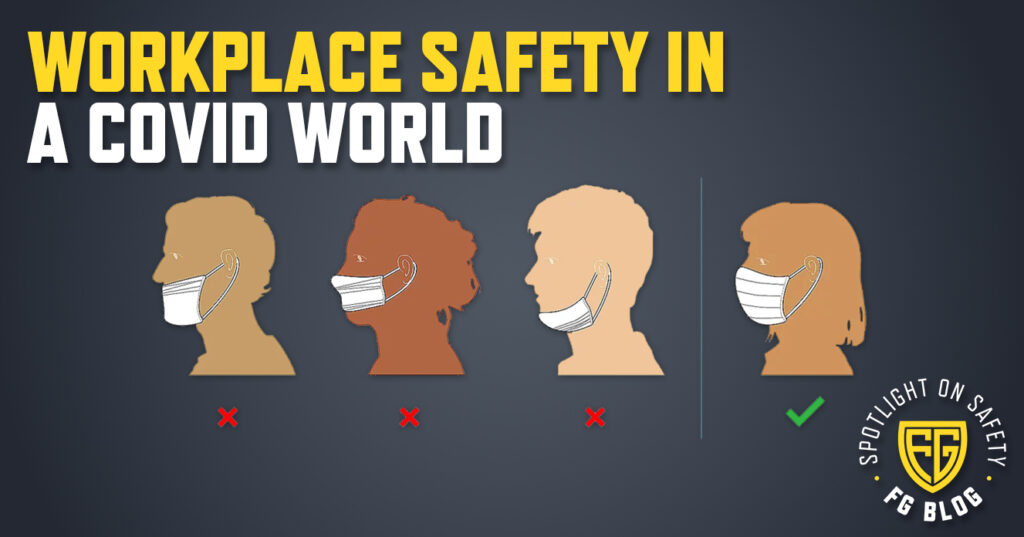Workplace Safety in a COVID World

Welcome back to Spotlight on Safety, where every month we discuss best practices for safety in the workplace! Safety is something that’s been on everyone’s minds in a big way for the last six months. We are all now closely and meticulously policing our own habits and interactions to ensure our safety and the safety of those around us. With many people returning to work, it’s important to discuss with your team how these new practices fit into your work environment.
COMMUNICATE
This is always a big theme in our Spotlight on Safety blogs. Communication is always important in regards to safety, but particularly in the midst of a pandemic, when the situation and policies can change from one day to the next. Make sure you have frequent team talks to update your staff (both office and plant floor) anytime a new policy is put in place, and make sure signage is updated to reflect new policies, as well.
At Folding Guard, we have weekly Team Talks to discuss safety. Now that we’re fully open for business again, COVID prevention methods are a key point in every talk. Make sure that copies of the Team Talk are sent to everyone so no one misses an update!
This is especially important if you still have staff working from home who might come into the office infrequently and not be aware of the updates. As always, make sure your signage and important meeting notes are translated to the first languages of your employees.
ACCOMMODATE
When every employee is risking their personal health by coming to work, it’s up to the company to make every possible accommodation to ensure that there are no extra unnecessary risks or hazards. You might need to put markers on the floor of your warehouse or manufacturing plant to remind employees to social distance while working at their stations. This might mean that you can’t have a full schedule of employees working simultaneously.
In an office setting, make sure that desks have cubicle or plexiglass partitions dividing them to prevent the spread of germs. Make sure that you not only enforce the proper use of Personal Protective Equipment, but provide masks or cloth face coverings for your staff. Accommodations are necessary; safety should never be sacrificed for the sake of efficiency, especially in a higher risk situation.
BE PROACTIVE
The best defense is a good offense: make sure you’re taking every measure to prevent the spread of the virus. Take employees’ (and visitors’) temperatures before they enter your facility, and send anyone who has a high temperature home. Make sure anyone presenting symptoms is tested. Ensure signs are up reminding employees and visitors to wash their hands regularly with soap and water for at least 20 seconds.
In addition, your workplace will probably need to be properly cleaned and fully sanitized more often than it used to be. In addition to regular cleanings that you have scheduled, you and your employees should sanitize your area before and after working, especially if that work space is shared.
Make sure your employees know which sanitizers and cleaning solutions to use in their work stations. Because many sanitizing agents have a high alcohol content (i.e. the CDC recommends at least a 60% alcohol based hand sanitizer), ensure the proper solutions are provided for each specific area; don’t use a solution with a high alcohol content in a work area with fire hazards (e.g. a welding station).
Another way to be proactive is to make sure you have a plan in place in the event that one of your employees does contract the virus. Make sure your employees know NOT to come into work if they have any symptoms.
If one of your employees does test positive, make sure everyone who might have been in contact with that person is notified and stays out of the workplace for two weeks. If someone tests positive, you’ll need to have a special cleaning crew come in (wearing protective gear) to completely sanitize your facility before anyone can return.
If you and your employees can be proactive about keeping their personal areas sanitized and the timely reporting of symptoms, you’ll be able to limit the spread of any contagions.
Be Smart, Be Safe – Plan Ahead
With Coronavirus on everyone’s minds, modern life has never been more stressful. Make sure your employees can come to work and feel at ease.
- Communicate openly about any new policies.
- Make accommodations where necessary (safety should always outweigh efficiency).
- Be proactive to keep your own workspace clean and sanitized.
If you can manage to implement these practices, you’ll make your workplace as safe as possible during this crisis.
To learn more about PPE and other good practices to keep a safe working environment, check out our other Spotlights on Safety!
